Hyundai Tucson: Connector Inspection Procedure
- Handling of Connector
a.Never pull on the wiring harness when disconnecting connectors.
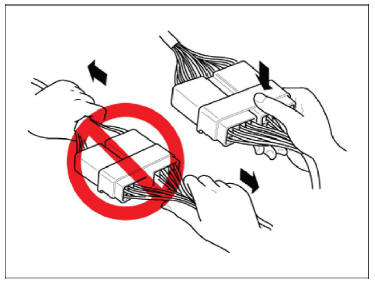
b.When removing the connector with a lock, press or pull locking lever.
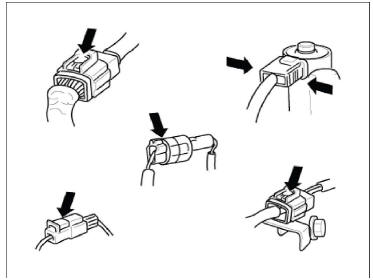
c.Listen for a click when locking connectors. This sound indicates that they are securely locked.
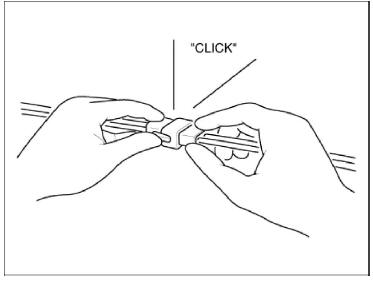
d.When a tester is used to check for continuity, or to measure voltage, always insert tester probe from wire harness side.
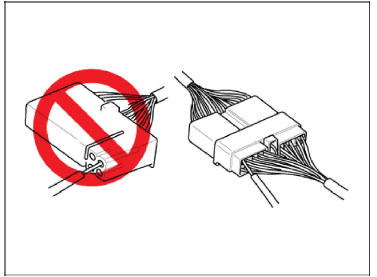
e.Check waterproof connector terminals from the connector side. Waterproof connectors cannot be accessed from harness side.

WARNING
- Use a fine wire to prevent damage to the terminal.
- Do not damage the terminal when inserting the tester lead.
- Checking Point for Connector
a.While the connector is connected: Hold the connector, check connecting condition and locking efficiency.
b.When the connector is disconnected: Check missed terminal, crimped terminal or broken core wire by slightly pulling the wire harness.
Visually check for rust, contamination, deformation and bend.
c. Check terminal tightening condition: Insert a spare male terminal into a female terminal, and then check terminal tightening conditions.
d.Pull lightly on individual wires to ensure that each wire is secured in the terminal.
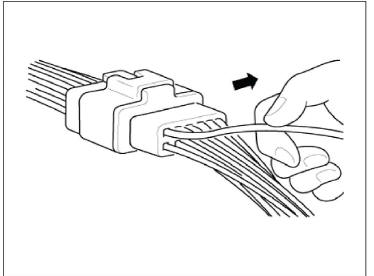
- Repair Method of Connector Terminal
a. Clean the contact points using air gun and/or shop rag.
WARNING
Never use sand paper when polishing the contact points, otherwise the contact point may be damaged.
b.In case of abnormal contact pressure, replace the female terminal.
Wire Harness Inspection Procedure
- Before removing the wire harness, check the wire harness position and crimping in order to restore it correctly.
- Check whether the wire harness is twisted, pulled or loosened.
- Check whether the temperature of the wire harness is abnormally high.
- Check whether the wire harness is rotating, moving or vibrating against the sharp edge of a part.
- Check the connection between the wire harness and any installed part.
- If the covering of wire harness is damaged; secure, repair or replace the harness.
READ NEXT:
 Electrical Circuit Inspection Procedure
Electrical Circuit Inspection Procedure
Check Open Circuit
Procedures for Open Circuit
Continuity Check
Voltage Check
If an open circuit occurs (as seen in FIG. 1), it can be found by
performing Step 2 (Continuity Check Method) or Step 3
(Voltage Check Method) as sho
 Symptom Troubleshooting Guide Chart
Symptom Troubleshooting Guide Chart
Specifications
Fuel Delivery System
Sensors
Manifold Absolute Pressure Sensor (MAPS)
Type : Piezo-Resistive Pressure
Sensor type
Specification
Intake Air Temperature Sensor (IATS)
Type : Termistor type
Specific
 Engine Control - Fuel System - Description and Operation
Engine Control - Fuel System - Description and Operation
Description
If the Gasoline Engine Control system components (sensors, ECM, injector, etc.)
fail, interruption to the fuel supply or failure
to supply the proper amount of fuel for various engine operating conditions will
result. The following
SEE MORE:
 Input shaft speed sensor- Installation
Input shaft speed sensor- Installation
Installation
Check that the shaft is in the "N" position.
Install the position sensor (A) and then lightly tighten the bolts.
Install the position sensor "N" fixing SST(No.:09430-2Cl 10).
Tighten position
 Charging System - Cleaning
Charging System - Cleaning
Make sure that the ignition switch and all accessories are in the OFF
position.
Disconnect the battery cables (negative first).
Remove the battery from the vehicle.
WARNING
Care should be taken in the event the battery case is cracked o
Information
- Home
- Hyundai Tucson - Fourth generation (NX4) - (2020-2023) - Owner's Manual
- Hyundai Tucson - Fourth generation (NX4) - (2020-2023) - Workshop Manual